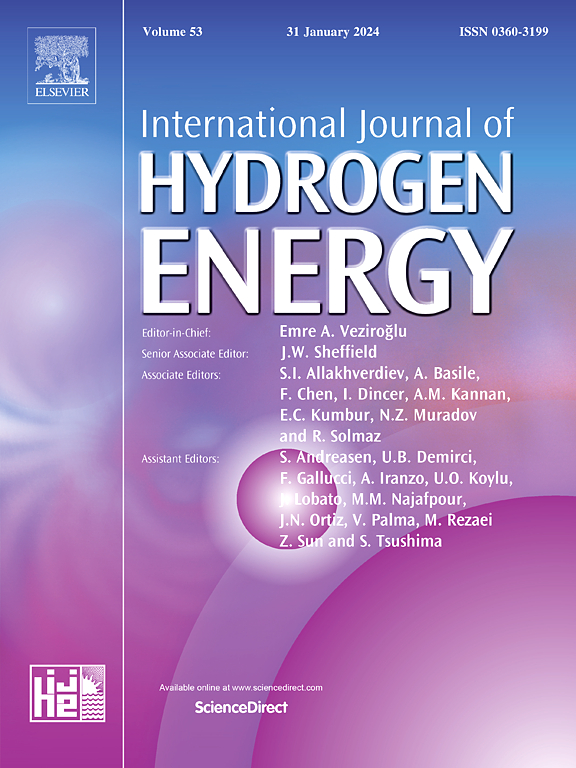Unveiling the Ni–S synergy in 3D porous carbon-supported NiS nanoparticles for enhanced oxygen evolution
IF 8.3
2区 工程技术
Q1 CHEMISTRY, PHYSICAL
引用次数: 0
Abstract
Despite the remarkable intrinsic activity and cost-effectiveness of nickel-sulfur (Ni–S) diatomic electrocatalysts, their widespread industrial adoption in water splitting systems remains hindered by an incomplete understanding of the synergistic interplay between nickel and sulfur species. To address this challenge, we developed a facile NaCl-template-assisted strategy combined with sequential carbonization and sulfidation processes, yielding three-dimensional porous carbon nanosheets embedded with NiS nanoparticles (NiS/PCNs). The optimized NiS/PCNs catalyst demonstrates superior alkaline oxygen evolution reaction (OER) performance, achieving a current density of 10 mA cm−2 at a low overpotential of 210 mV in 1 M KOH, accompanied by a favorable Tafel slope of 69 mV dec−1 and exceptional durability (99 % activity retention over prolonged operation). Moreover, DFT calculations reveal an innovative “aggregation-rebalance” mechanism governing Ni–S interactions. This dynamic process induces electron redistribution across metallic surfaces, facilitating charge convergence and transfer dynamics. Consequently, the energy barrier of the OER rate-determining step is substantially reduced, rationalizing the enhanced catalytic efficiency of NiS nanoparticles. This work achieves dual advancements: A scalable synthesis route for constructing three-dimensional porous architectures with optimized mass/charge transport capabilities; Fundamental elucidation of atomic-level Ni–S synergy through computational-experimental integration. The proposed design paradigm extends beyond Ni–S systems, offering a universal framework for developing transition metal chalcogenide electrocatalysts.
揭示了Ni-S在三维多孔碳负载NiS纳米颗粒中的协同作用,以增强析氧
尽管镍-硫(Ni-S)双原子电催化剂具有显著的内在活性和成本效益,但由于对镍和硫之间的协同相互作用的不完全理解,阻碍了它们在水分解系统中的广泛工业应用。为了解决这一挑战,我们开发了一种简单的nacl模板辅助策略,结合顺序碳化和硫化过程,产生了嵌入NiS纳米颗粒的三维多孔碳纳米片(NiS/PCNs)。优化后的NiS/PCNs催化剂表现出优异的碱性析氧反应(OER)性能,在1 M KOH下,过电位为210 mV,电流密度为10 mA cm−2,Tafel斜率为69 mV dec−1,并且具有优异的耐久性(在长时间运行中保持99%的活性)。此外,DFT计算揭示了一种控制Ni-S相互作用的创新“聚集-再平衡”机制。这一动态过程诱导了电子在金属表面的重新分布,促进了电荷的收敛和转移动力学。因此,OER速率决定步骤的能量势垒大大降低,使NiS纳米颗粒的催化效率增强变得合理。这项工作取得了双重进展:构建具有优化质量/电荷传输能力的三维多孔结构的可扩展合成路线;通过计算-实验集成对原子级Ni-S协同作用的基本阐释。所提出的设计范例超越了Ni-S系统,为开发过渡金属硫系电催化剂提供了一个通用框架。
本文章由计算机程序翻译,如有差异,请以英文原文为准。
求助全文
约1分钟内获得全文
求助全文
来源期刊

International Journal of Hydrogen Energy
工程技术-环境科学
CiteScore
13.50
自引率
25.00%
发文量
3502
审稿时长
60 days
期刊介绍:
The objective of the International Journal of Hydrogen Energy is to facilitate the exchange of new ideas, technological advancements, and research findings in the field of Hydrogen Energy among scientists and engineers worldwide. This journal showcases original research, both analytical and experimental, covering various aspects of Hydrogen Energy. These include production, storage, transmission, utilization, enabling technologies, environmental impact, economic considerations, and global perspectives on hydrogen and its carriers such as NH3, CH4, alcohols, etc.
The utilization aspect encompasses various methods such as thermochemical (combustion), photochemical, electrochemical (fuel cells), and nuclear conversion of hydrogen, hydrogen isotopes, and hydrogen carriers into thermal, mechanical, and electrical energies. The applications of these energies can be found in transportation (including aerospace), industrial, commercial, and residential sectors.
 求助内容:
求助内容: 应助结果提醒方式:
应助结果提醒方式:


